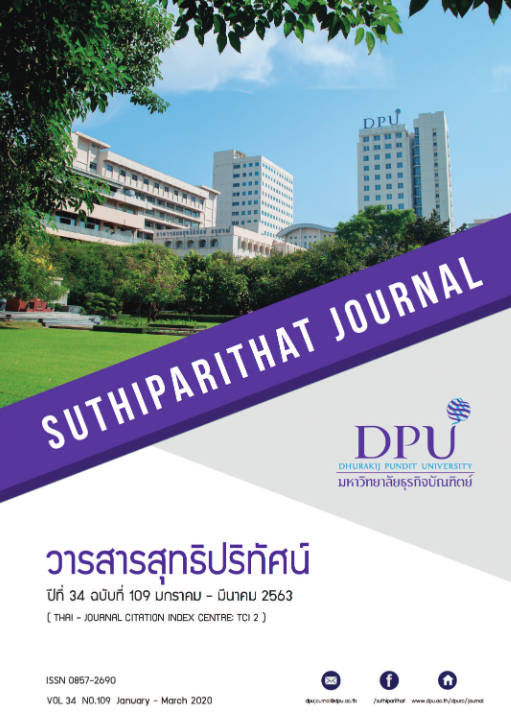การวิเคราะห์องค์ประกอบสมรรถนะนักวิจัยสร้างสรรค์งานนาฏศิลป์: กรณีศึกษานักศึกษาระดับปริญญาตรี สถาบันบัณฑิตพัฒนศิลป์
คำสำคัญ:
การวิเคราะห์องค์ประกอบ, สมรรถนะนักวิจัยสร้างสรรค์งานนาฏศิลป์, สถาบันบัณฑิตพัฒนศิลป์บทคัดย่อ
การวิจัยครั้งนี้วัตถุประสงค์เพื่อวิเคราะห์องค์ประกอบสมรรถนะนักวิจัยสร้างสรรค์งานนาฏศิลป์ของนักศึกษาระดับปริญญาตรี สถาบันบัณฑิตพัฒนศิลป์ ประชากรที่ใช้ในการวิจัยครั้งนี้คือ นักศึกษาระดับปริญญาตรี ชั้นปีที่ 4 สาขานาฏศิลป์ไทย ในสถาบันบัณฑิตพัฒนศิลป์ 14 แห่งทั่วประเทศ จำนวน 568 คน เก็บรวบรวมข้อมูลด้วยแบบสอบถามสมรรถนะนักวิจัยสร้างสรรค์งานนาฏศิลป์ทำการวิเคราะห์ความตรงเชิงเนื้อหา ค่าอำนาจจำแนกและความเที่ยงของแบบสอบถาม สถิติที่ใช้ในการวิจัยคือ การวิเคราะห์องค์ประกอบเชิงสำรวจ (Exploratory Factor Analysis: EFA) ผลการวิจัยพบว่า สมรรถนะนักวิจัยสร้างสรรค์งานนาฏศิลป์ มีจำนวน 18 องค์ประกอบ ประกอบด้วย (1) ทักษะปฏิบัติผสานประสบการณ์ (2) ความมุ่งมั่นและรับผิดชอบ (3) การออกแบบศิลป์ (4) การวาดภาพทางความคิด (5) การคิดวิเคราะห์ (6) การแสวงหาความรู้สู่การสร้างสรรค์ (7) ทักษะปฏิบัติขั้นสูง (8) ทักษะการสื่อสาร (9) การพัฒนาตนเองและการให้เกียรติผู้อื่น (10) ความซื่อสัตย์ทางวิชาการ (11) ความรู้ทั่วไปด้านนาฏศิลป์ไทย (12) การกำหนดขอบเขตงาน (13) การประยุกต์ใช้ (14) ความใจกว้าง (15) ความรู้บริบทด้านการแสดง (16) การมีใจฝักใฝ่ (17) การสร้างแรงบันดาลใจ และ (18) ความเป็นเอกลักษณ์เฉพาะตน โดยทั้ง 18 องค์ประกอบนี้สามารถอธิบายความแปรปรวนที่เกิดขึ้นได้ร้อยละ 67.324 หมายความว่าชุด ตัวแปรที่นำมาวิเคราะห์สามารถนำมาอธิบายเรื่องที่ศึกษาได้
เอกสารอ้างอิง
จันทิมา ใหญ่ยิ่ง. (2552). การศึกษาคุณลักษณะบัณฑิตที่สำเร็จการศึกษา สาขาวิชานาฏศิลป์ไทย คณะศิลปนาฏดุริยางค์ สถาบันบัณฑิตพัฒนศิลป์ (วิทยานิพนธ์ปริญญามหาบัณฑิต). กรุงเทพฯ: มหาวิทยาลัยศรีนครินทรวิโรฒ.
ฉันทนา เอี่ยมสกุล. (2554) ศิลปะการออกแบบท่ารำ (นาฏศิลป์ไทยสร้างสรรค์). กรุงเทพฯ: คณะศิลปกรรมศาสตร์ มหาวิทยาลัยธรรมศาสตร์.
ณัฐกานต์ บุญศิริ. (2556). แนวทางการผลิตบัณฑิตระดับปริญญาตรีด้านนาฏยศิลป์ (ปริญญานิพนธ์ปริญญาดุษฎีบัณฑิต). มหาสารคาม: มหาวิทยาลัยมหาสารคาม.
ดาริณี ชำนาญหมอ. (2545). ระบำรำเต้น. กรุงเทพฯ: คณะศิลปกรรมศาสตร์ มหาวิทยาลัยศรีนครินทรวิโรฒ.
ธนากร จันทนะสาโร. (2557). นาฏยศิลป์จากแนวคิดไตรลักษณ์ในพระพุทธศาสนา (ปริญญานิพนธ์ปริญญาดุษฎีบัณฑิต). กรุงเทพฯ: จุฬาลงกรณ์มหาวิทยาลัย.
พีรพงศ์ เสนไสย. (2546). นาฏยประดิษฐ์. กาฬสินธุ์: ประสานการพิมพ์.
เย็นใจ เลาหวณิช. (2526). ประเภทของการวิจัย การวิจัยด้านมนุษยศาสตร์และศิลปะของนักวิชาการไทย. กรุงเทพฯ: สำนักพิมพ์จุฬาลงกรณ์มหาวิทยาลัย.
วิโชค มุกดามณี. (2557). ศิลปินกับการทำงานวิจัยสร้างสรรค์. จดหมายข่าวประชาคมวิจัย, 20(115), 8-10.
วิทยาลัยช่างศิลปสุพรรณบุรี. (2557). KM ด้านวิจัยเรื่อง การจัดทำผลงานสร้างสรรค์เชิงงานวิจัยประจำปีงบประมาณ 2557. สุพรรณบุรี: วิทยาลัยช่างศิลปสุพรรณบุรี สถาบันบัณฑิตพัฒนศิลป์.
วิรุณ ตั้งเจริญ. (2544). ทัศนศิลปวิจัย. กรุงเทพฯ: โรงพิมพ์สันติศิริการพิมพ์.
ศุภชัย จันทร์สุวรรณ์. (2547). การศึกษาวิเคราะห์วิธีการร่ายรำ และลีลาท่ารำของโขนตัวพระ กรณีศึกษาตัวพระราม (ปริญญานิพนธ์ปริญญาดุษฎีบัณฑิต). กรุงเทพฯ: จุฬาลงกรณ์มหาวิทยาลัย.
สมบูรณ์ สุริยวงศ์. (2550). การวิเคราะห์องค์ประกอบ. กรุงเทพฯ: มหาวิทยาลัยรามคำแหง.
สมาพร คล้ายวิเชียร. (2556). การวิจัยเชิงสร้างสรรค์ศิลปะ กรณีศึกษาการสร้างสรรค์ผลงานจิตรกรรมสื่อผสม: ความกลัวในวิถีชีวิต. วารสารวิชาการศิลปะสถาปัตยกรรมศาสตร์ มหาวิทยาลัยนเรศวร, 4(1), 115-125.
สุรชัย ทุหมัด, ประสพชัย พสุนนท์, และธีรวัฒน์ จันทึก. (2561). การวิเคราะห์องค์ประกอบเชิงสำรวจการจัดการคุณภาพองค์การกับประสิทธิผลการปฏิบัติงานของพนักงานมหาวิทยาลัยในกำกับของรัฐ. วารสารสุทธิปริทัศน์, 32(102), 70-85.
สุวิมล ติรกานันท์. (2553). การวิเคราะห์ตัวแปรพหุในงานวิจัยทางสังคมศาสตร์. กรุงเทพฯ: โรงพิมพ์แห่งจุฬาลงกรณ์มหาวิทยาลัย.
แสงอรุณ โปร่งธุระ. (2539). พุทธศาสน์. กรุงเทพฯ: ฝ่ายเอกสารตำรา สำนักส่งเสริมวิชาการสถาบันราชภัฏธนบุรี.
อธิศร์ เทียนประเสริฐ. (2557). งานวิจัยกับการสร้างสรรค์งานศิลป์. จดหมายข่าวประชาคมวิจัย, 20(115), 11-12.
Field, A. (2009). Discovering statistics using SPSS (3rd ed.). London: SAGE Publications.
ดาวน์โหลด
เผยแพร่แล้ว
รูปแบบการอ้างอิง
ฉบับ
ประเภทบทความ
สัญญาอนุญาต
เนื้อหาและข้อมูลในบทความที่ลงตีพิมพ์ในวารสารสุทธิปริทัศน์ ถือเป็นข้อคิดเห็นและความรับผิดชอบของผู้เขียนบทความโดยตรงซึ่งกองบรรณาธิการวารสาร ไม่จำเป็นต้องเห็นด้วย หรือร่วมรับผิดชอบใด ๆ
บทความ ข้อมูล เนื้อหา รูปภาพ ฯลฯ ที่ได้รับการตีพิมพ์ในวารสารสุทธิปริทัศน์ ถือเป็นลิขสิทธิ์ของวารสารสุทธิปริทัศน์หากบุคคลหรือหน่วยงานใดต้องการนำทั้งหมดหรือส่วนหนึ่งส่วนใดไปเผยแพร่ต่อหรือเพื่อกระทำการใด ๆ จะต้องได้รับอนุญาตเป็นลายลักษณ์อักษรจากวารสารสุทธิปริทัศน์ก่อนเท่านั้น







